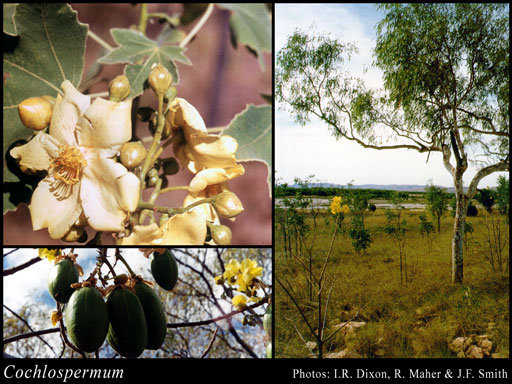- Reference
- Nov.Gen.Sp.Pl. 5:297 (1823)
- Name Status
- Current

Scientific Description
Common name. Cotton Trees. Family Cochlospermaceae.
Habit and leaf form. Trees, or shrubs; evergreen, or deciduous (often deciduous); with coloured juice (having yellow, orange or red sap). Leaves cauline. Stem internodes solid (ass.). Leaves alternate; petiolate; non-sheathing; gland-dotted, or not gland-dotted; aromatic, or without marked odour; simple, or compound; palmate (3–9 lobes). Leaflets ovate; cordate. Leaf blades dissected, or entire (divided for less than half length); orbicular (more or less); palmately lobed; palmately veined; cross-venulate; cordate. Leaves with stipules. Leaf blade margins serrate. Leaves without a persistent basal meristem. Leaf anatomy. Hairs present (velvety), or absent. Extra-floral nectaries absent (ass.). Stem anatomy. Secondary thickening developing from a conventional cambial ring.
Reproductive type, pollination. Fertile flowers hermaphrodite. Unisexual flowers absent. Plants hermaphrodite.
Inflorescence and flower features. Flowers aggregated in ‘inflorescences’; in racemes, or in panicles. Inflorescences terminal, or axillary; racemes loose, few-flowered. Flowers pedicellate (densely tomentose-pubescence); bracteate (each flower subtended by 1 bract, narrowly ovate to ovate, glabrous to sericeous, caducous). Bracts deciduous. Flowers ebracteolate; large; regular (KB), or somewhat irregular (somewhat zygomorphic). Free hypanthium absent. Perianth with distinct calyx and corolla; 8, or 10; 2 -whorled; isomerous. Calyx present; 5 (outer 2 shorter, inner 3 contorted, asymmetric); 1 -whorled; polysepalous; imbricate; not persistent (deciduous). Sepals ovate. Corolla present; 5; 1 -whorled; polypetalous; imbricate; yellow. Petals obovate. Corolla members emarginate. Androecial members indefinite in number. Androecium 25–100 (‘many’). Androecial members branched (with trunk bundles); maturing centrifugally; free of the perianth; all equal (ass.); free of one another. Androecium exclusively of fertile stamens. Stamens 20–100 (many); all more or less similar in shape (ass.); polystemonous; on disc between stamens and ovary. Anthers basifixed; dehiscing via pores (1 apical pore and sometimes an additional 2 small, basal pores). Gynoecium 3–5 carpelled. The pistil 1 celled. Gynoecium syncarpous; eu-syncarpous; superior. Ovary unilocular; 1 locular; sessile. Gynoecium stylate. Styles 1; attenuate from the ovary; apical. Stigmas 1 (minute). Placentation parietal. Ovules in the single cavity 20–100 (i.e. ‘many’); anatropous.
Fruit and seed features. Fruit non-fleshy (woody); dehiscent (ass.); a capsule. Capsules three to five valvular. Fruit 3–5 celled; 20–100 seeded (many). Seeds endospermic. Endosperm oily. Cotyledons 2. Embryo straight, or curved, or coiled. Micropyle zigzag.
Geography, cytology, number of species. World distribution: widespread-tropical, except Malaysia.
Etymology. From the Greek for "a shellfish with a spiral shell" and "seed"; the seeds of some species are spirally twisted.